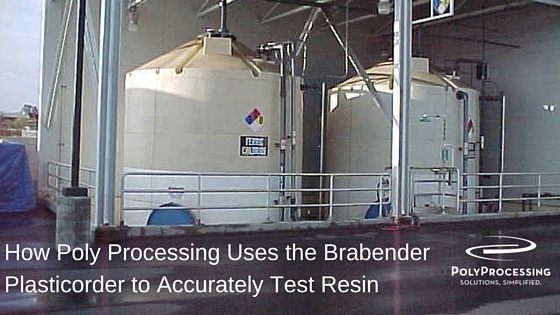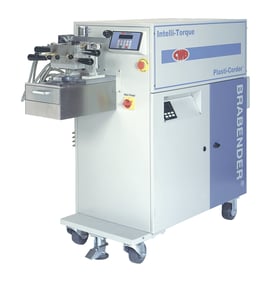How Poly Processing Uses the Brabender Plasticorder to Accurately Test Resin

In any chemical process, consistency and reliability are key. Not only do you want to know what the incoming materials consist of but you also need to know how they react when they're used in engineering. One of the ways Poly Processing ensures both reliability and uniformity is through various quality control steps and tests. One of those tests is using a Brabender Plasticorder to test the resin we use to make our tanks.
How is Resin Made?
The resin comes from the manufacturer and goes to a compounder. Chemicals and additives are added to the resin for additional durability, UV protection, as well as making the resin crosslinkable, producing crosslinked polyethylene or XLPE. The resin is turned into pellets which are then taken and pulverized into a powder. That powder is used in the rotational molding machines to mold XLPE tanks.
Why the Resin is tested
Poly Processing has always had long-standing relationship with knowledgeable and experienced third-party entities that ensure superior products that surpass industry standards. In this case, the resin powder is sent to Penn College, where they not only validate the materials from the compounder and resin supplier to make sure it meets agreed upon manufacturing standards, they also use a Brabender machine to test the resin. In addition, the Brabender test is conducted at the compounders facility on every lot of material produced and results are sent to Poly Processing.
What is a Brabender?
A Brabender Plasticorder is a torque rheometer. Resin is loaded into the mixing bowl attachment on the Brabender where it is tested using counter rotating rotors at a prescribed temperature and RPM to determine how the material performs.
The Brabender machine is used to define how the resin behaves and gives a baseline measurement based on the specific batch of resin being tested. The information gleaned from the Brabender also allows for the right temperature and manufacturing parameters for the rotomolding process.
Not only is the Brabender a significant piece of the quality control system but it underlines how Poly Processing uses these types of steps when developing new materials. In this instance, there's no other real way to test the resin when it arrives at the manufacturing facility so Poly Processing uses the Brabender test results to set the standard and ensure a high-quality polyethylene tank for your chemical storage needs.
To learn more about Poly Processing’s quality standards, contact a chemical storage tank expert today.
- March 4, 2016
- Topics: Value Added, Tank Design and Materials
About Poly Processing
Posts By Topic
Tech Talk Podcast Episodes
Subscribe By Email
Recent Posts
- Installation Tips for Chemical Storage Tanks: Site Preparation and Offloading
- Understanding pH and Chemical Concentration When Choosing a Chemical Tank
- Maximizing Fill Efficiency: Selecting the Optimal Fill Line System
- Chemical Storage Tanks: A Quick Guide for End Users
- Popular Customization Options for Chemical Storage Tanks
Tank Configurator

Find the recommended tank and system components for your chemical storage challenge.
Configure a Tank Package


